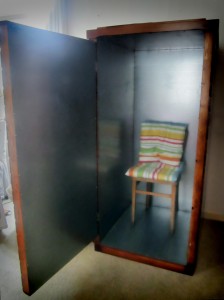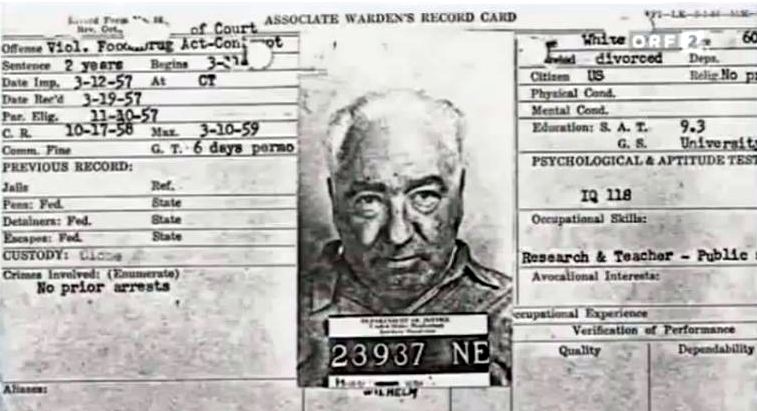
 A cure for the common cold and cancer, the power to bring rain down from the clouds, arguably the worst case of U.S. government censorship and book-burning, UFOs and a weapon of mass destruction using the power of sex…the list goes on and on. What do these have to do with high strangeness in New England? Two words: Wilhelm Reich.
A cure for the common cold and cancer, the power to bring rain down from the clouds, arguably the worst case of U.S. government censorship and book-burning, UFOs and a weapon of mass destruction using the power of sex…the list goes on and on. What do these have to do with high strangeness in New England? Two words: Wilhelm Reich.
The next time you find yourself in the Rangeley Lakes region of Maine, you might find your way up the Dodge Pond Road. There, nested in the woods, you will find a museum dedicated to one of the most interesting and controversial figures ever to settle in the great state of Maine: Wilhelm Reich. The Wilhelm Reich Trust maintains the Wilhelm Reich Museum, known to the wide world as Orgonon. Many people outside of the state are aware of this man’s life and legacy, but most Mainer’s have never heard of him. His life parallels the lives of some of the last century’s greatest movers and shakers, including Sigmund Freud and Albert Einstein. Today, Wilhelm Reich remains a footnote in history, but at one time, he was on everyone’s radar.
Wilhelm Reich’s story begins in Austria on March 27, 1897. He was a member of a hard-working and educated Jewish family and he matriculated through school during the First World War. In 1919 he met Sigmund Freud when he asked the famous psychiatrist for a reading list. Within a year, Reich was working for Freud at the Vienna Ambulatorium, Freud’s outpatient clinic. Within another year he was a member of the Vienna Psychoanalytic Association and was nearly the next door neighbor of Freud on Berggasse 7. Before he eventually left Vienna, he was advocating adolescent sex, birth control, and abortions. Many credit Reich as the Father of Free Love. Reich would move forward to become one of the most radical scientists of his time and would influence an entire generation of intellectuals with his theories. It was a strong introduction into the world of science. He had so much promise at the beginning of his career.
As a man of his time, he was obsessed with ideas that previous generations had kept quiet and under the covers. Reich is credited with coining the term ‘orgone.’ Orgone is a portmanteau word derived from the terms ‘orgasm’ and ‘organism.’ The concept of orgone is that it is a massless, omnipresent substance everywhere in the universe, like the aether described by the ancients. It accumulated in living substances, such as humans, but it was also present everywhere in nature, even in the clouds above our heads. Orgone, he claimed, powered the northern lights, ball lightning, and red blood cells. More importantly, orgone was the power behind sexual orgasms and this power according to his theories, was a potential power source for the world. This power, he claimed, could be harnessed and used as energy. His ideas were largely passed off as pseudoscience, but that did not stop Reich from building and selling inventions that accumulated orgone for productive uses. Many intellectuals of his time became adherents of his theories. He was not simply written off in the early days.

Reich emigrated to New York in 1939 to escape the Nazis and set up shop building inventions that looked like small, metal-lined, portable closets called ‘orgone accumulators.’ Cancer cells he reasoned, were full of orgone, so full that they grew wildly. He claimed that if a person sat inside one of these, health would improve and that the excess orgone inside of cancer cells could be sucked out of them and into the air of the box, to better used in other parts of the body. Newspapers at the time made light of the idea of ‘sex’ boxes that ‘cured cancer,’ but that didn’t stop Reich from advertising and selling these devices and making money selling his ‘cure.’ It also didn’t stop him from advertising and making a great deal of money from his ideas.
Reich was one of those people in history who rides the edge of acceptability. There is a fine line between genius and madness and that line was tested in December of 1941 when Wilhelm Reich went to Princeton, New Jersey to meet with Albert Einstein.Why Einstein agreed to meet with Reich remains a matter of controversy. Reich was a communist Jew from central Europe who hated the Fascist Powers. So was Einstein. Reich was the pupil of Freud, so it was not a stretch of the imagination to think that Einstein would agree to meet with Reich and discuss his theories.Their first meeting consisted of a five hour talk discussing Reich’s theories of orgone and its properties. When he claimed that an object’s temperature could be raised without any apparent source of heat except for orgone, he then took the idea further, claiming that orgone could be used to build a bomb.After their second meeting, Reich gave Einstein a small orgone accumulator and over the following ten days, Einstein performed experiments, noting the temperature of the device as it sat in his basement. He did observe a rise in temperature, but Einstein’s assistant pointed out that the effect was easily explained by the temperature gradient in the room. Einstein’s penultimate communication with Reich came in the form of a letter which stated, “Through these experiments I regard this matter as completely solved.” Later, Reich pestered Einstein, unable to accept his conclusions and even threatening to publish their previous communications in the press. Einstein asked that his name simply not be used for any advertising purposes. Reich could never shake the idea that Einstein had somehow been convinced by some other outside force to distance himself from Reich. Reich never forgave Einstein for abandoning him.
In November of 1942, Reich’s true connection with Maine begins with the purchase of an old farm on Dodge Road in Rangeley. He dubbed the place ‘Orgonon’ after his theory and lived there in the summers. In 1950, he and his family moved there year round. Several colleagues followed him including two physicians. Books were published there and the property is still connected with Reich as a kind of memorial to his ideas in the form of a museum bearing his name.
In 1951, Reich claimed to have discovered another form of energy he called ‘Deadly Orgone Radiation’ or DOR. He thought that high concentrations of DOR could cause desertification and he believed that he had discovered a way to create clouds and make it rain using his original orgone accumulator. He created a series of fifteen foot long aluminum tubes in rows, all connected to cables that were connected to a water source. He believed this device somehow unblocked the orgone energy in the atmosphere and allowed the clouds to rain.

According to the Bangor Daily News in its July 24th, 1953 edition, Reich brought his contraption to a blueberry barren outside of Ellsworth, Maine off the shore of Grand Lake. According to Myron Sharaf on page 379 of his book ,Fury on Earth, the Bangor Daily News reported that “according to a reliable source, the following climactic changes took place on the night of July 6 and the early morning of July 7. ‘Rain began to fall shortly after ten o’clock Monday evening, first as a drizzle and then by midnight as a gentle steady rain. Rain continued throughout the night and a rainfall of 0.24 inches was recorded in Ellsworth the following morning. “A puzzled witness to the rain-making process said: ‘The queerest looking clouds you ever saw began to form soon after they got the thing rolling.’ And later the same witness said the scientists were able to change the course of the wind by manipulation of the device. The machine, it seems, might have worked. He continued to work with his cloud-buster and began to have a much larger audience than before, but success was never something that Wilhelm Reich could rightfully claim without criticism and complaint.
Reich’s life began to take on the aspect of a falling star: he burned brightest just before fading into obscurity. The United States Food and Drug Administration spent years interviewing Reich’s patients and students looking for a way to stop him from promoting his theories, eventually focusing on his invention, the Orgone Accumulator. On the 29th of July, 1952, three FDA investigators arrived in Rangeley to inquire about the veracity of the accumulators. Reich responded with anger, telling them that they needed to read his works before he would interact with them. In February of 1954, the United States Attorney for the District of Maine filed a 27 page complaint against Reich. He was accused to violating Sections 301 and 302 of the Federal Food, Drug, and Cosmetic Act by shipping his Orgone Accumulators and promotional literature across state lines. Reich refused to appear in court to address the accusations. On March 19, 1954, Judge Clifford ordered all of the accumulators, their parts and instructions be destroyed and that any books mentioning orgone be ‘withheld.’
This last injunction seems the most disturbing. Reich had fled Nazi-held Austria where books were confiscated and burned and now, in the United States, his books, however odd and off-center, were being treated similarly. By order of a United States judge, on the 23rd of August, 1956, six tons of Reich’s books, journals and papers were burned in the 25th Street public incinerator in New York. There were books that had been collected by the government since 1954. To make matters worse, Reich’s institution, the Orgone Press, had to pay for the expenses and labor involved in the destruction of his own work. The destruction of Wilhelm’s Reich’s words has been cited by civil libertarians as one of the worst examples of censorship in the history of the United States. Victor Sobey, an associate of Reich, claimed “It felt like people who, when they are to be executed, are made to dig their own graves first and are then shot and thrown in. We carried box after box of literature. In today’s world, so many strange theories abound that it is difficult to fathom the thoughts of those government men in the 1950s who burned books as though it was for the good of the country. It has to be stressed that in the 1950’s the Red Scare was rife in America and Wilhelm Reich was an avowed Communist. He did not try to hide his association with the Communist Party and perhaps this explains the ferocity with which the government responded to his ideas and theories – as a communist plot against democracy and freedom.
Reich spiraled downward into his own paranoia. He appealed the lower court’s decision in 1956 but the decision was upheld and the Supreme Court of the United States refused to hear the case. On the 12th of March, 1953, Reich was admitted to Danbury Federal Prison with delusions of grandeur, psychosis, and paranoia, according to psychiatrist Richard Hubbard, who examined him at the time. While in prison, Reich even applied for a presidential pardon, which was not granted.
During the morning roll call on the November 3rd, Reich failed to appear. He had died in his sleep on his bed, fully clothed but for his shoes. The cause of death was determined to be sudden heart failure. At the time of his death, no academic journals mentioned his passing. Time Magazine wrote “Died. Wilhelm Reich, 60, once-famed psychoanalyst, associate and follower of Sigmund Freud, founder of the Wilhelm Reich Foundation, lately better known for unorthodox sex and energy theories, of a heart attack…while serving a two-year term for distributing this invention, the ‘orgone energy accumulator’ (in violation of the Food and Drug Act), a telephone-booth-size device that supposedly gathered energy from the atmosphere and could cure, while the patient sat inside, common colds, cancer and impotence.”
Today, you can visit his grave and his museum in Rangeley Maine. You can see a cloud buster and an orgone accumulator. The website for the Wilhelm Reich Infant Trust hosts a vast amount of information on Reich’s theories and inventions. It seems that the United States government ultimately failed to suppress his ideas and he still has enough fame to deliver over 17 million hits on a Google search of his name. Though he is considered a fringe scientist of his day, he remains a mystery; an obviously intelligent man able to consort with the likes of Freud and Einstein, but whose radical thinking and his connection to the Communist Party, caused the government of the United States to burn his books and suppress his memory.
BIBLIOGRAPHY
Sharaf, Myron, “Fury on Earth: A Biography of Wilhelm Reich“, 1994, Da Capo Press, New York.
Turner, Christopher, “Adventures in the Orgasmatron: How the Sexual Revolution Came to America“, 2011, Farrar, Straus and Giroux, New York.
Time Magazine, “Milestones, Nov. 18, 1957”, 18 November 1957.
Wilhelm Reich Museum – Rangeley, Maine




